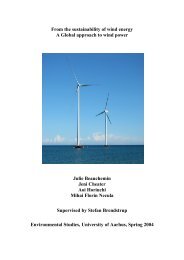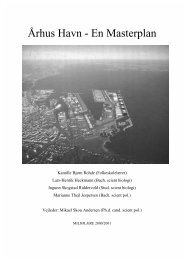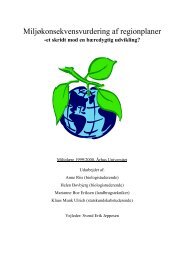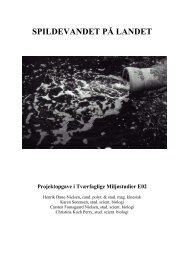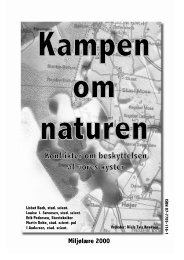University of Aarhus ECOTOURISM AS A WAY TO PROTECT ...
University of Aarhus ECOTOURISM AS A WAY TO PROTECT ...
University of Aarhus ECOTOURISM AS A WAY TO PROTECT ...
Create successful ePaper yourself
Turn your PDF publications into a flip-book with our unique Google optimized e-Paper software.
Ecotourism as a sustainable way to protect nature<br />
are found around the coast, where dolphins, whales and sea turtles are also<br />
common.<br />
3.1.3. History<br />
Galapagos had no aboriginal inhabitants before the 1900s, probably<br />
because <strong>of</strong> the extreme scarcity <strong>of</strong> water. The tenth <strong>of</strong> March 1535 the Spanish<br />
Bishop Tomás de Berlanga arrived to Galapagos as the first known arrival <strong>of</strong><br />
humans. He recorded the island and described the nature scene. The discovery<br />
made no impact on the Spanish conqueror or on the English and Dutch<br />
navigators, because no great minerals were found (Galapagos Conservation<br />
Trust, 2002).<br />
During 1600 buccaneers and pirates used the islands as a staging post, for<br />
restocking on water and repairing their boats before carrying out raids on the<br />
mainland. They caught the giant tortoises, which they brought with them alive<br />
on board their ships for fresh meat (Galapagos Conservation Trust, 2002).<br />
In the 1800 whaling ships and fur-sealers used Galapagos as a resting<br />
spot. They collected tortoises for food and fine “turtle oil” (Galapagos<br />
Conservation Trust, 2002). The whalers nearly decimated not only the whales<br />
but also the tortoise population before 1860. Fortunately the bottom fell out <strong>of</strong><br />
the whaling industry (Honey, 1999).<br />
In 1835 a young British aristocrat, Charles Darwin stopped at Galapagos<br />
while sailing around the world during a five years expedition. He spent five<br />
weeks observing the nature. His observation changed the western scientific<br />
thought. Darwin noted two important phenomena “that wildlife, with no natural<br />
predators, was unusually tame, and that many <strong>of</strong> the islands had developed their<br />
own unique species <strong>of</strong> animals, birds and plants”. These observations gave rise<br />
to his book about evolution by natural selection (Honey, 1999).<br />
43





